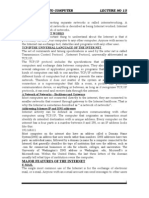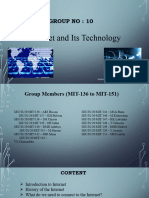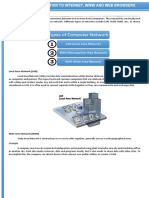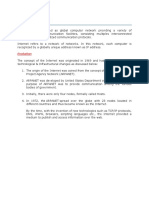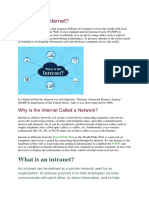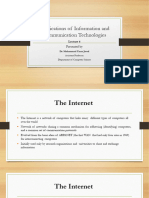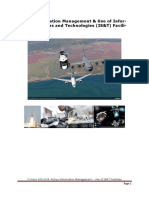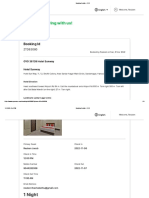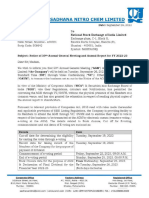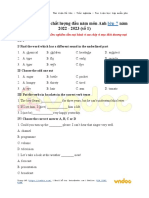Unit 4: The Internet 5 hrs
Definition, Internet services (Electronic Mail, File Transfer, Telnet, Usenet news,
and WWW), Uses of internet, Internet address
Definition:
What is the Internet?
Internet is a global network that connects billions of computers across the world with each
other and to the World Wide Web. It uses standard internet protocol suite (TCP/IP) to connect
billions of computer users worldwide. It is set up by using cables such as optical fibers and other
wireless and networking technologies. At present, internet is the fastest mean of sending or
exchanging information and data between computers across the world.
It is believed that the internet was developed by "Defense Advanced Projects Agency" (DARPA)
department of the United States. And, it was first connected in 1969.
Internet services
Electronic Mail:
Email stands for Electronic Mail. It is a method to send messages from one computer to another
computer through the Internet. It is mostly used in business, education, technical
communication, and document interactions. It allows communicating with people all over the
world without bothering them. In 1971, a test email was sent Ray Tomlinson to himself
containing text.
�It is the information sent electronically between two or more people over a network. It involves
a sender and receiver/s.
File Transfer:
File transfer is the process of transmitting digital files from one computer or system to another
over a network or internet connection. It enables the secure and efficient movement of files
between devices, locations or organizations, facilitating information sharing and collaboration in
digital environments.
File transfer is usually governed by communication protocols, which are sets of rules that define
how information is transmitted between computers in a network. Common protocols used
today include File Transfer Protocol (FTP), Transmission Control Protocol (TCP) and Hypertext
Transfer Protocol (HTTP). These protocols facilitate secure and reliable file transmission and
support everything from simple web browsing to complex data transfers involving sensitive
information.
Telnet:
Telnet is a client/server protocol that allows users to access remote systems and perform
actions on them. It's used to emulate a remote computer terminal, so users can interact with it
as if it were local.
How it works
1. Install a Telnet client on your computer.
2. Open the client and type a command to connect to a remote computer.
3. The client sends a request to the remote computer to establish a connection.
4. If the connection is accepted, you'll be prompted to log in with a username and
password.
5. Once logged in, you can control the remote computer as if you were sitting in front of it.
Usenet news:
Usenet is the contraction of the User Network. It resembles just a Bulletin Board System where
users can post articles or posts on various topics.
�The Usenet of newsgroups is hierarchical and, similar to the Domain Name System (DNS). A
usenet is a collection of user-submitted articles or posts on various topics/subjects that are
posted to servers on world wide network.
WWW:
WWW stands for World Wide Web and is commonly known as the Web. The WWW was started
by CERN in 1989. WWW is defined as the collection of different websites around the world,
containing different information shared via local servers(or computers).
Web pages are linked together using hyperlinks which are HTML-formatted and, also referred to
as hypertext, these are the fundamental units of the Internet and are accessed through
Hypertext Transfer Protocol(HTTP). Such digital connections, or links, allow users to easily access
desired information by connecting relevant pieces of information. The benefit of hypertext is it
allows you to pick a word or phrase from the text and click on other sites that have more
information about it.
Uses of internet:
Generally speaking, the Internet may be used to exchange information with people all over the
world, communicate across great distances, and locate information or answers fast on almost
any subject.
Here are some examples of specific uses for the Internet:
Using social media and content sharing.
� Instant messaging, video conferencing, Internet Relay Chat (IRC), Internet telephony, and
email are all examples of electronic communication. These all are used through the
Internet.
Access to online degree programs, courses, and workshops for education and self-
improvement.
Searching for jobs: To advertise available positions, submit job applications, and hire
candidates identified on social networking sites like LinkedIn, both employers and
applicants use the Internet.
Other examples include:
Online dating
Online gaming
Research
Reading electronic newspapers and magazines
Online shopping, or e-commerce.
Online discussion groups and forums
Internet address
IP address
�An IP address represents a unique address that distinguishes any device on the internet or any
network from another. IP or Internet Protocol defines the set of commands directing the setup
of data transferred through the internet or any other local network.
An IP address is the identifier that enables your device to send or receive data packets across
the internet. It holds information related to your location and therefore making devices
available for two-way communication. The internet requires a process to distinguish between
different networks, routers, and websites. Therefore, IP addresses provide the mechanism of
doing so, and it forms an indispensable part in the working of the internet. You will notice that
most of the IP addresses are essentially numerical. Still, as the world is witnessing a colossal
growth of network users, the network developers had to add letters and some addresses as
internet usage grows.


